Uses
Bleomycin is used to treat cancer. It works by slowing or stopping the growth of cancer cells.This medication may also be used to control the build-up of fluid around the lungs (pleural effusion) caused by tumors that have spread to the lungs. For this condition, bleomycin is placed in the space around the lungs through a chest tube.
How to use Bleomycin SULFATE Vial
This medication is given by injection into a vein, into a muscle, or under the skin by a health care professional. It is given as directed by your doctor, usually once or twice a week. When giving this medication into a vein, it is injected slowly over 10 minutes. Tell your health care professional right away if you experience any chest pain. The medication may need to be stopped or injected more slowly. The dosage is based on your medical condition, body size, and response to treatment.
If you are receiving this medication through a chest tube into the space around the lungs, the solution is usually left in place for 4 hours and then drained out through the chest tube. Your doctor may direct you to change positions during the 4 hours to make sure the solution treats all parts of your lungs.
Side Effects
See also Warning section.
Pain/redness at the injection site, fever, chills, vomiting, loss of appetite, weight loss, darkening of the skin, or changes in fingernails/toenails may occur. Changes in diet such as eating several small meals or limiting activity may help lessen some of these effects. In some cases, drug treatment may be necessary to prevent or relieve nausea and vomiting. If any of these effects last or get worse, tell your doctor or pharmacist promptly.
Temporary hair loss may occur. Normal hair growth should return after treatment has ended.
People using this medication may have serious side effects. However, you have been prescribed this drug because your doctor has judged that the benefit to you is greater than the risk of side effects. Careful monitoring by your doctor may decrease your risk.
Painful sores on the lips, mouth, and throat may occur. To decrease the risk, limit hot foods and drinks, brush your teeth carefully, avoid using mouthwash that contains alcohol, and rinse your mouth often with cool water.
Bleomycin can commonly cause skin reactions (such as redness, itching, blisters, rash, swelling), usually in the second or third week of treatment. These reactions are not always serious. However, you may not be able to tell them apart from signs of a severe reaction. Tell your doctor right away if you develop any skin reaction.
Tell your doctor right away if you have any serious side effects, including: nausea that doesn't stop, dizziness/fainting, fast/pounding heartbeat, numbness/tingling, feeling of coldness in hands/feet, easy bruising/bleeding, pale/bluish skin, coughing up blood, vomit that looks bloody or like coffee grounds, signs of infection (such as sore throat that doesn't go away), signs of kidney problems (such as change in the amount of urine, pink urine), mental/mood changes (such as confusion, aggression), stomach/abdominal pain, dark urine, yellowing eyes/skin.
Get medical help right away if you have any very serious side effects, including: weakness on one side of the body, vision changes, trouble speaking, chest pain.
A very serious allergic reaction to this drug is rare. However, get medical help right away if you notice any symptoms of a serious allergic reaction, including: confusion, rash, itching/swelling (especially of the face/tongue/throat), severe dizziness, trouble breathing.
This is not a complete list of possible side effects. If you notice other effects not listed above, contact your doctor or pharmacist.
In the US -
Call your doctor for medical advice about side effects. You may report side effects to FDA at 1-800-FDA-1088 or at www.fda.gov/medwatch.
In Canada - Call your doctor for medical advice about side effects. You may report side effects to Health Canada at 1-866-234-2345.
Warnings
Rarely, bleomycin can cause a serious, allergic-like reaction. It is most common in lymphoma patients. Before your main treatment with this drug begins, your doctor may direct you to receive a smaller test dose to check for signs of this serious reaction. Tell your doctor right away if any of the following serious side effects occur: dizziness/fainting, confusion, fever, chills, trouble breathing.
Severe (sometimes fatal) lung problems (lung scarring) have rarely occurred in patients using this drug. This reaction is more likely in patients older than 70 years. The risk of this reaction increases as you receive more doses of this drug. This problem may occur anytime during treatment. Tell your doctor right away if you experience any of these serious side effects: cough, fever, chills, chest pain, or difficult/painful breathing.
Precautions
Before using bleomycin, tell your doctor or pharmacist if you are allergic to it; or if you have any other allergies. This product may contain inactive ingredients, which can cause allergic reactions or other problems. Talk to your pharmacist for more details.
Before using this medication, tell your doctor or pharmacist your medical history, especially: immune system problems (such as chemotherapy, bone marrow problems), kidney disease, liver disease, lung problems.
This medication may make your lungs more sensitive to oxygen treatment. Tell your doctor or dentist that you have used this medication before having surgery or any treatment where oxygen may be used.
Older adults may be at greater risk for side effects (such as lung problems) while using this drug.
Tell your doctor if you are pregnant or plan to become pregnant. You should not become pregnant while using bleomycin. Bleomycin may harm an unborn baby. If you become pregnant, talk to your doctor right away about the risks and benefits of this medication.
It is unknown if this drug passes into breast milk. Because of the possible risk to the infant, breastfeeding is not recommended while using this drug. Consult your doctor before breastfeeding.
Interactions
Drug interactions may change how your medications work or increase your risk for serious side effects. This document does not contain all possible drug interactions. Keep a list of all the products you use (including prescription/nonprescription drugs and herbal products) and share it with your doctor and pharmacist. Do not start, stop, or change the dosage of any medicines without your doctor's approval.
Some products that may interact with this drug include: brentuximab, digoxin, drugs that may harm the kidneys (for example, aminoglycosides such as gentamicin, cisplatin), phenytoin.
Overdose
If someone has overdosed and has serious symptoms such as passing out or trouble breathing, call 911. Otherwise, call a poison control center right away. US residents can call 1-800-222-1222. Canada residents can call 1-844-764-7669.
Lab and/or medical tests (such as chest X-rays, complete blood counts, kidney/liver function) should be done while you are using this medication. Keep all medical and lab appointments. Consult your doctor for more details.
It is important to get each dose of this medication as scheduled. If you miss a dose, ask your doctor or pharmacist right away for a new dosing schedule.
Not applicable. This medication is given in a hospital or clinic and will not be stored at home.
Images
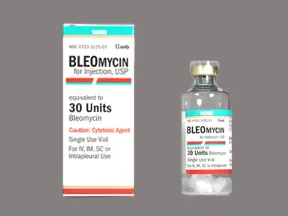
bleomycin 30 unit solution for injection
Color: colorlessShape: Imprint:This medicine is a colorless, vial
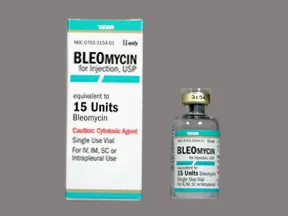
bleomycin 15 unit solution for injection
Color: colorlessShape: Imprint:This medicine is a colorless, vial
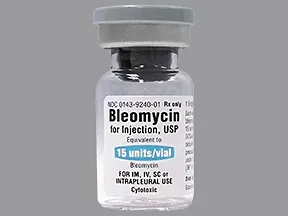
bleomycin 15 unit solution for injection
Color: clearShape: Imprint:This medicine is a colorless, vial

bleomycin 30 unit solution for injection
Color: colorlessShape: Imprint:This medicine is a colorless, vial
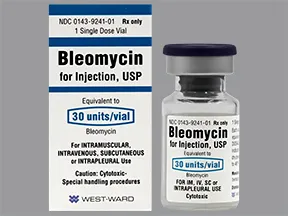
bleomycin 30 unit solution for injection
Color: clearShape: Imprint:This medicine is a colorless, vial
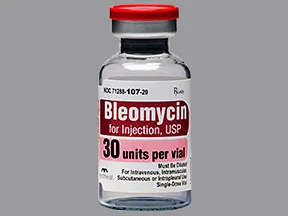
bleomycin 30 unit solution for injection
Color: colorlessShape: Imprint:This medicine is a colorless, vial
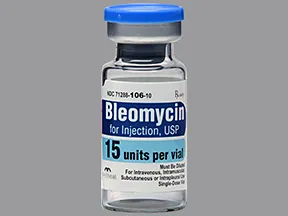
bleomycin 15 unit solution for injection
Color: colorlessShape: Imprint:This medicine is a colorless, vial
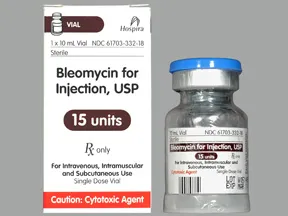
bleomycin 15 unit solution for injection
Color: creamShape: Imprint:This medicine is a colorless, vial

bleomycin 30 unit solution for injection
Color: Shape: Imprint:This medicine is a colorless, vial

bleomycin 15 unit solution for injection
Color: colorlessShape: Imprint:This medicine is a colorless, vial
You Might Also Like
Are you currently using Bleomycin SULFATE Vial?
This survey is being conducted by the WebMD marketing sciences department.
Selected from data included with permission and copyrighted by First Databank, Inc. This copyrighted material has been downloaded from a licensed data provider and is not for distribution, except as may be authorized by the applicable terms of use.
CONDITIONS OF USE: The information in this database is intended to supplement, not substitute for, the expertise and judgment of healthcare professionals. The information is not intended to cover all possible uses, directions, precautions, drug interactions or adverse effects, nor should it be construed to indicate that use of a particular drug is safe, appropriate or effective for you or anyone else. A healthcare professional should be consulted before taking any drug, changing any diet or commencing or discontinuing any course of treatment.